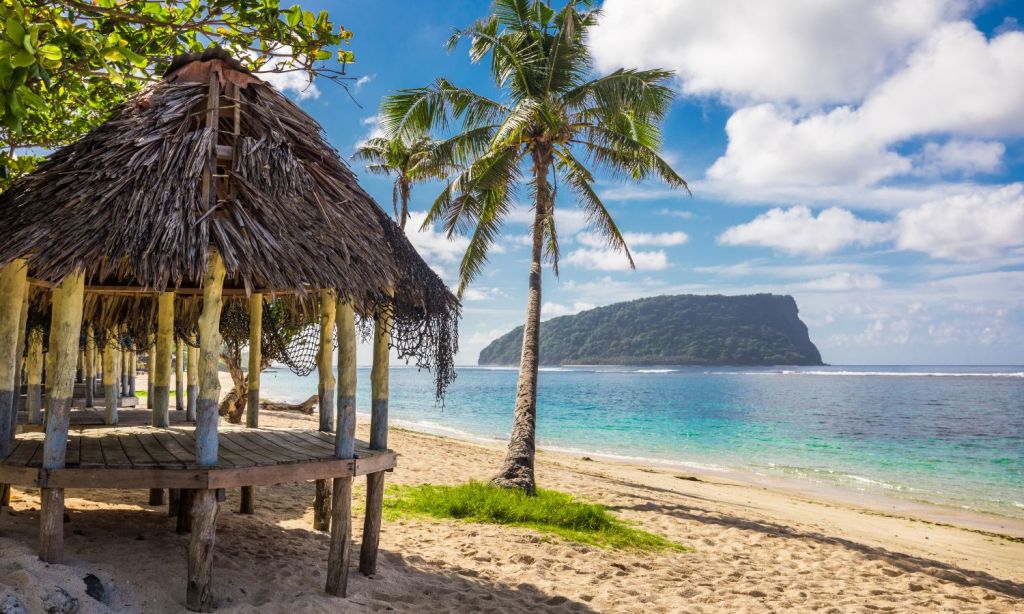I’m drying off from a swim in a cave pool when I notice a family with too many kids to count making lunch. They were in what I would learn was called a ‘beach fale’ (pronounced “fah-ley”).
The fale looks like a wooden gazebo, stilted off the ground and thatching over a tin roof that makes it resemble a hut. Many also don’t have walls on their sides. Beach fales are common in Samoa, the island in the South Pacific where I was.
“Beach fales can be used for resting, bus stop shelters or just a place to hang out,” Fasitau Ula, Samoa Tourism Authority Australia’s marketing manager later told me. “Property built fales are for hosting guests.”
In that context, they’re operated by local families who host guests as day visitors or for overnight stays. The operators will provide bedding necessities, which is usually a soft mat on the ground, pillow and blanket, and often breakfast and dinner. Some fales have ensuites, but most are shared facilities.
“Some people see them as Samoa’s version of Airbnb or camping, but the difference [with the Airbnb comparison] is that Samoan beach fales have existed for years – long before Airbnb.”
The beach fale with the tuna-loving family I’d spotted was part of a handful of day-use fales scattered around Piula Cave Pool, a freshwater pool with a cave to one side of it. It was a Saturday, and the pool was filled with local families. They splashed around it in the water before drying off to lunch or nap in their fales.
“Aren’t you worried your stuff will get stolen?” I asked a part-Australian and part-Samoan accommodation owner I met on my trip to Samoa. Though many fales had blinds or tarps that could be rolled down at night, all the ones I’d spotted had their sides open.
“No,” she said. “There are so many people around.”
While I chickened out on staying overnight at a beach fale (I worried I wouldn’t be able to sleep in the mugginess without aircon), in hindsight, I wish I had. They play a key role in Samoan culture, which sees family as an integral part of one’s daily life. In Samoa, the average family has five kids. Some larger fales accommodate up to 20 people sleeping on their floor, I was also told.
Aside from experiencing a beach fale (if you’re up for it!), there’s plenty else you can do in Samoa, many of the attractions and activities unique to the nation. Ahead, I’m sharing four highlights from my trip to Samoa earlier this year. I got to the island nation from Sydney on Virgin Australia via Brisbane. The airline operates five services from Brisbane to Samoa per week, with a flight time of just under five hours.
Swim in Piula Cave Pool
Piula Cave Pool, which I mentioned earlier with day fales alongside it, is a freshwater natural pool with a cave you can swim under. Spot the darting fish in crystal-clear water before lowering yourself in from the pool’s rocky sides. Note that the cave is deep in some parts, including under the cave. It’s open Mondays to Saturdays from 8am-4pm and no alcohol is allowed. You’ll need to pay an entry fee.
Climb Into Sua Ocean Trench
In Samoan, ‘Sua Ocean Trench‘ means ‘giant swimming hole’. Formed during an ancient lava eruption when the land around it slipped away, today, the hole is easily the most recognisable Samoan sight. Admire it from above before climbing down its long ladder to the water. At the bottom of the ladder, you’ll find a deck you can rest on after swimming. The ocean trench requires an entry fee.
Attend a Samoan Church Service
Religion plays a big part in Samoan culture, with most attractions, activities and even petrol stations closed on Sundays. For a memorable travel experience, join a Sunday church service, where you can join in the choir singing, blow kisses at the babies crawling down the aisle and see the congregation spill onto the church after the service, where they’ll mingle before heading home for family lunch. Ask about the church service time at your accommodation and dress in all-white out of respect.
Visit the Robert Louis Stevenson Museum
The Robert Louis Stevenson Museum is in the former home of Scottish author Robert Louis Stevenson who wrote Strange Case of Dr. Jekyll and Mr. Hyde and Treasure Island. See where Stevenson and his family slept, worked and relaxed in the 1800s. The museum is open Tuesdays to Sundays from 12-4pm, with tours running for 45 minutes.
Related: 6 of the Coolest Things You Can Do in Vanuatu’s Capital
Related: Want to Escape the Crowds in Fiji? Try These 5 Underrated South Pacific Islands Instead
Read more stories from The Latch and subscribe to our email newsletter.

